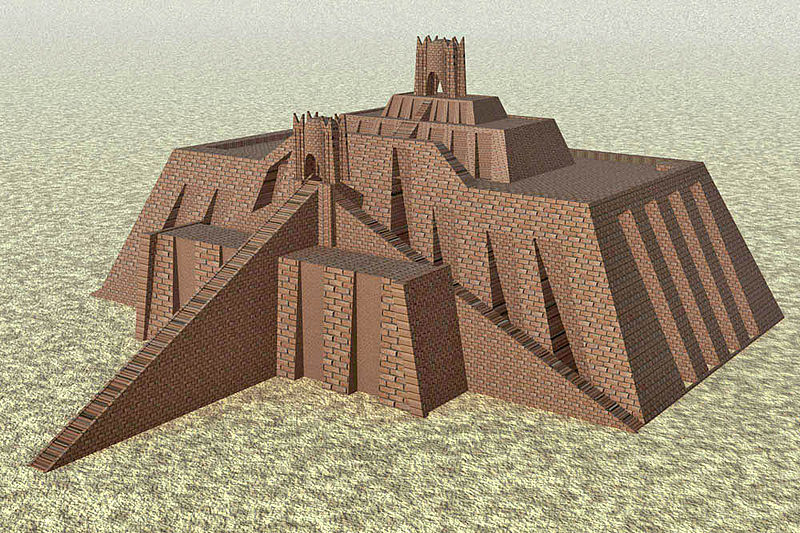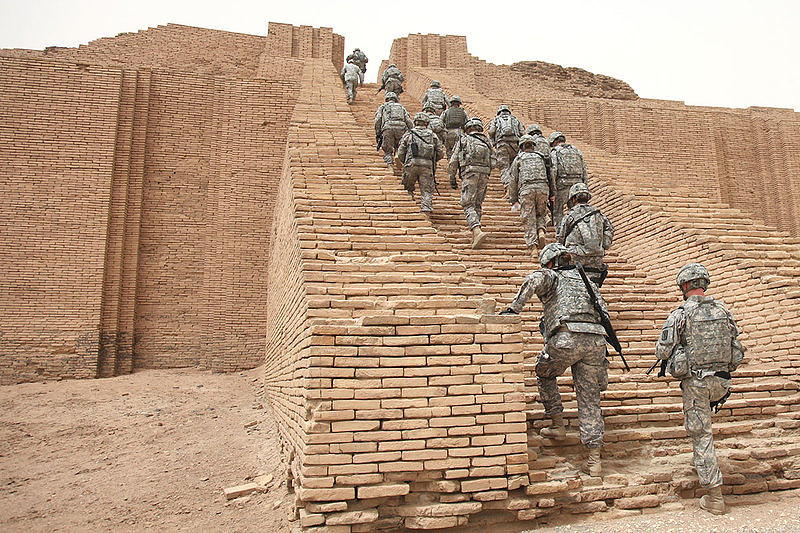Great Ziggurat of Ur (Ziggurat Etemenniguru) is the best preserved temple complex in Ancient Mesopotamia, (Iraq). It was constructed in early in the century of the XXI BC. NS. (about 2047 BC) in the city of Ur by the local kings Ur Nammu and Shulgi as well as the Ekishnugal Sanctuary to honor the lunar god Nanna. In the following years, it was restored several times, and was substantially expanded by New Babylonian king Nabonidus.
Ziggurat at Ur
Ziggurat of Ur-Nammu — The Sumerian civilization gave the world the first written language and the first examples of literary creativity. In the ancient city of Ur, discovered in modern Iraq, strange and ominous tombs of the Sumerian kings have been found. Also, archaeologists have investigated a magnificent example of ancient architecture - the mysterious ziggurat tower. It has survived to this day, having gone through several very turbulent millennia.
Ziggurat ur Iraq – In fact, there were many Sumerian cities - in the valley for a long time, there were several independent city-states, each of which was ruled by its ruler. The Sumerian civilization had gone through many periods when the center of political power moved from one city to another - these or those rulers, gaining strength, began to dictate their will. Until they were replaced by a stronger and more sophisticated rival in the struggle for power. In general, nothing new - everything is as it always was and almost everywhere. However, at the same time, no matter what political winds were blowing, all Sumerian cities had a typical cultural and historical relationship - a single written language, similar methods of doing trade, the same religion. Each city built its temple in a multi-stage pyramid, which was called a Ziggurat.
Sumerian Ziggurat – The construction of the great Ziggurat of Ur was supervised by the 3rd dynasty Ur that restored the local Sumerian statehood following The Akkadians as well as the Gutians. Zigurat at Ur was intended to be the temple, and also as an institution for the public, archive and palace of the royal family. From its summit, the entire city was visible with a clear view.
Ziggurats at Ur was a twenty-meter-high brick structure built on platforms with various sizes, and an area of 44 by 46 metres having three levels. The foundation was constructed from mud bricks, while the walls on the outside were covered with stones slabs.
First Image / Source
Image / Source
The Ziggurat of Ur
Temple of Ur – The entire structure building was covered with bricks that were treated with bitumen. Three ascents similar to ladders (a high central one, and two side ones joined with a third at the very top) lead to the first platform. From there, the steps lead to a superstructure made of brick, which was where the main temple of the goddess of the moon Nanna was situated. In the walls supporting the platforms, there were numerous rooms where temple staff lived. Priests also used the platform on the top to watch the stars.
Ur Ziggurat – The structure's superstructure is not surviving. The first person who explored the building, Leonard Woolley, believed that the stairs are planted with tree in the early times to ensure that the entire structure could remind the people of the alluvial plain the sacred mountain.
Ziggarat at Ur was a revered model for architects from Ancient Mesopotamia. It is possible the Etemenniguru ziggurat or the ziggurat in Babylon constructed upon its model functioned as a model to that of the Tower of Babel described in the Bible.
 |
| Ziggurat of Ur - Predessor to the Pyramid - photograghed when the structure was re-discovered in the late 19th century. |
Image / Source
Great Ziggurat of Ur
The Great Ziggurat – At the turn of 20th-century the team to Leonard Woolley from the British Museum cleaned the ziggurat of long-standing layers. After that, it was partially rebuilt. The ziggurat's courtyard Woolley discovered the remains of an archive of the temple clay tablet with details regarding trade deals and rituals in which priests were the representative of the lunar god.
Ziggurat Iraq – In the years 1979-1980, under the rule of Saddam Hussein, with the approval of the Iraqi Antiquities Directorate, the facades of the building all the way to the top and the massive staircase were rebuilt. According archaeologists "It was the right decision, otherwise, after excavation, it would have crumbled!" Presently this US Ali Air Base lies just 2 kilometers south-west of the ziggurat. Nearby, are the remains from the ancient temple built by Nebuchadnezzar II. The nearest city to the temple is Nasiriya.
Image / Source
Image / Source
Image / Source
Image / Source
Image / Source
Ziggurat of Ur Location
Image / Source
SOURCE ► WIKIPEDIA / KHANACADEMY / SMARTHISTORY










No comments:
Post a Comment